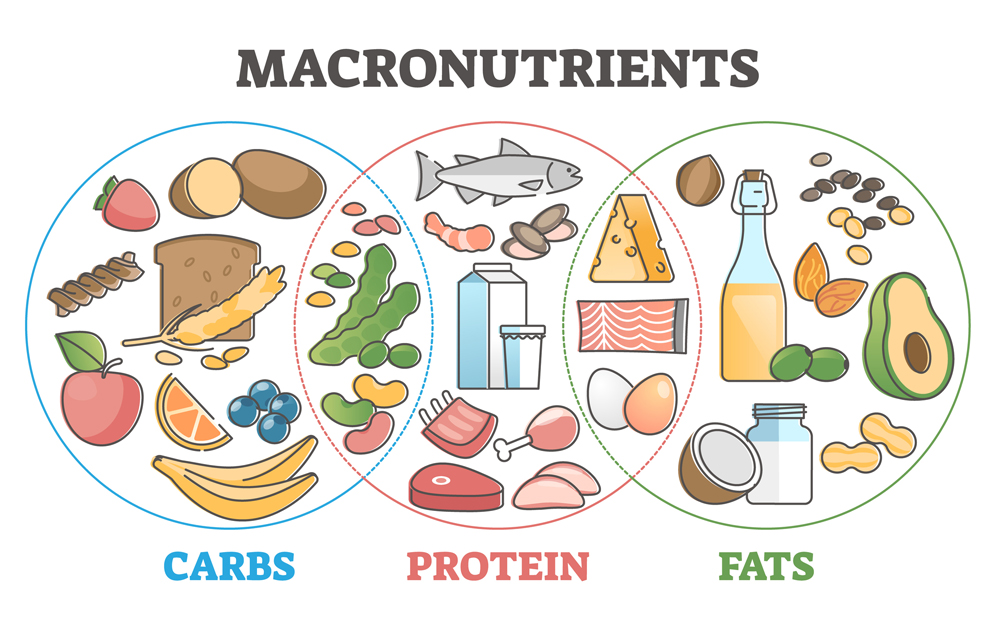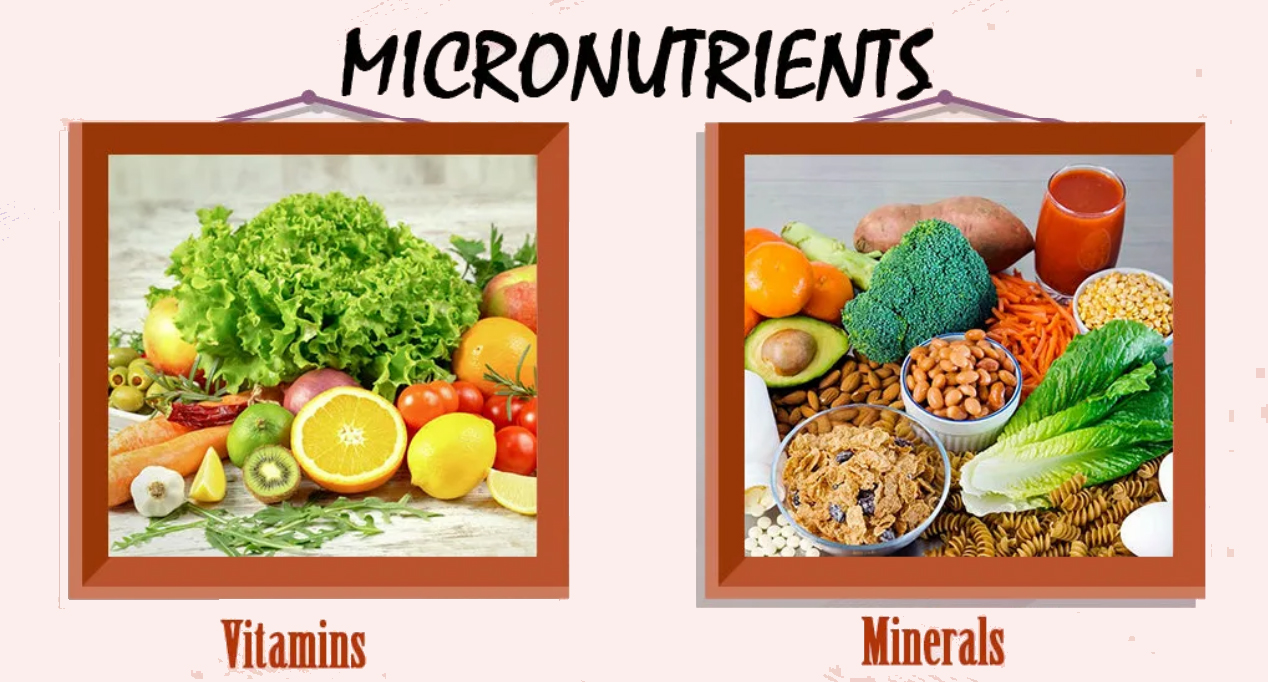Macronutrients
Micronutrients


Carbohydrates, fat and protein are called macronutrients. They are the nutrients you use in the largest amounts. “Macronutrients are the nutritive components of food that the body needs for energy and to maintain the body’s structure and systems
Micronutrients are vitamins and minerals needed by the body in very small amounts . However, their impact on a body’s health are critical, and deficiency in any of them can cause severe and even life-threatening conditions.
Carbohydrate (Carbs) molecules contain carbon, hydrogen, and oxygen atoms. Carbohydrates play an important role in the human body. They act as an energy source, help control blood glucose and insulin metabolism, participate in cholesterol and triglyceride metabolism, and help with fermentation. The digestive tract begins to break down carbohydrates into glucose, which is used for energy upon consumption. Any extra glucose in the bloodstream is stored in the liver and muscle tissue until further energy is needed. Carbohydrates is an umbrella term that encompasses sugar, fruits, vegetables, fibers, and legumes. While there are numerous divisions of carbohydrates, the human diet benefits mostly from a certain subset.
Fats are nutrients in food that the body uses to build cell membranes, nerve tissue (including the brain), and hormones. The body also uses fat as fuel. If fats eaten aren’t burned as energy or used as building blocks, they’re stored by the body in fat cells. This is the body’s way of thinking ahead: By saving fat for future use, it plans for times when food might be scarce.
- Protein is an important part of a healthy diet.
- Proteins are made up of chemical ‘building blocks’ called amino acids.
- Your body uses amino acids to build and repair muscles and bones and to make hormones and enzymes. They can also be used as an energy source.
Vitamins are essential for a properly functioning metabolism. The body is unable to produce most vitamins by itself, so it needs to absorb them through food. We need 13 vitamins in particular. An overview of the key information is below.
The body needs vitamins to survive. They may not supply any energy, but they play an essential role in the human metabolism. All foods contain a certain amount of vitamins. However, as a general rule, the fresher and less processed your food, the better. Some vitamins are sensitive to heat, light or oxygen, which can lower the vitamin content of food. This means it’s important to prepare fruit and vegetables carefully. Unlike minerals, vitamins can be produced synthetically. Synthetic vitamins have the same chemical structure as natural vitamins and therefore have the same effect. If vitamins are synthetically added to foods, these are known as fortified foodstuffs.
In human nutrition, 13 vitamins play an important role. The body can produce vitamins D and B3 itself, but all other vitamins need to be absorbed through food. Vitamins are either water-soluble or fat-soluble. The technical term for the latter is “lipophilic vitamins”. They are most easily absorbed in combination with fat, such as olive oil. The body stores these vitamins up in fat tissue and the liver. As a result, it is less apparent if we occasionally consume less of these vitamins, or even develop a deficiency. Water-soluble vitamins are known as “hydrophilic vitamins”. They are distributed in parts of the body containing water, such as the blood and intercellular space. The body is unable to store water-soluble vitamins, with the exception of vitamin B12.
Minerals are those elements on the earth and in foods that our bodies need to develop and function normally. Those essential for health include calcium, phosphorus, potassium, sodium, chloride, magnesium, iron, zinc, iodine, chromium, copper, fluoride, molybdenum, manganese, and selenium.
Vitamins:
| Vitamin | Where It’s Found | Benefits | Deficiencies |
|---|---|---|---|
| Vitamin A | Liver, carrots, sweet potatoes | Vision health, immune function, skin health | Night blindness, dry skin, impaired immune function |
| Vitamin B1 (Thiamine) | Whole grains, pork, nuts | Energy metabolism, nerve function | Beriberi, Wernicke-Korsakoff syndrome |
| Vitamin B2 (Riboflavin) | Dairy products, leafy greens | Cell growth, energy production | Ariboflavinosis, skin disorders, inflammation |
| Vitamin B3 (Niacin) | Meat, fish, nuts | Cholesterol regulation, skin health | Pellagra, dermatitis, diarrhea |
| Vitamin B5 (Pantothenic Acid) | Avocado, eggs, yogurt | Hormone synthesis, energy metabolism | Fatigue, irritability, numbness |
| Vitamin B6 (Pyridoxine) | Poultry, bananas, chickpeas | Neurotransmitter synthesis, red blood cell formation | Anemia, dermatitis, depression |
| Vitamin B7 (Biotin) | Eggs, nuts, seeds | Metabolism, hair and nail health | Hair loss, skin rash, neurological symptoms |
| Vitamin B9 (Folate) | Leafy greens, legumes, citrus fruits | DNA synthesis, fetal development | Anemia, birth defects, cognitive impairments |
| Vitamin B12 (Cobalamin) | Meat, fish, dairy products | Nerve function, DNA synthesis | Anemia, fatigue, neurological symptoms |
| Vitamin C | Citrus fruits, bell peppers, strawberries | Antioxidant, collagen synthesis, immune support | Scurvy, weakened immune system, easy bruising |
| Vitamin D | Sunlight, fatty fish, fortified foods | Bone health, immune function | Rickets, osteomalacia, weakened immune function |
| Vitamin E | Nuts, seeds, vegetable oils | Antioxidant, skin health, immune function | Peripheral neuropathy, muscle weakness, vision problems |
| Vitamin K | Leafy greens, broccoli, Brussels sprouts | Blood clotting, bone health | Excessive bleeding, poor bone health |
Minerals:
| Mineral | Where It’s Found | Benefits | Deficiencies |
|---|---|---|---|
| Calcium | Dairy products, leafy greens, fortified foods | Bone health, muscle function, nerve transmission | Osteoporosis, rickets, bone fractures |
| Iron | Red meat, poultry, lentils | Oxygen transport, energy metabolism | Anemia, fatigue, weakness |
| Magnesium | Nuts, seeds, whole grains | Muscle function, bone health, energy production | Muscle cramps, abnormal heart rhythms, osteoporosis |
| Phosphorus | Meat, dairy, whole grains | Bone health, energy metabolism | Weakness, bone pain, fragile bones |
| Potassium | Bananas, potatoes, beans | Blood pressure regulation, muscle function, nerve transmission | Hypertension, muscle weakness, irregular heartbeat |
| Sodium | Table salt, processed foods | Fluid balance, nerve function, muscle contraction | Hyponatremia, muscle cramps, dizziness |
| Chloride | Salt, seaweed, olives | Electrolyte balance, digestive function | Dehydration, muscle cramps, electrolyte imbalance |
| Zinc | Shellfish, legumes, seeds | Immune function, wound healing, DNA synthesis | Growth retardation, impaired immune function, hair loss |
| Copper | Shellfish, nuts, seeds | Iron metabolism, connective tissue formation | Anemia, osteoporosis, joint pain |
| Manganese | Whole grains, nuts, seeds | Antioxidant activity, bone health, metabolism | Impaired growth, reproductive issues, skeletal abnormalities |
| Selenium | Brazil nuts, seafood, organ meats | Antioxidant defense, thyroid function | Weakness, hair loss, thyroid dysfunction |
| Iodine | Seafood, iodized salt | Thyroid hormone synthesis, metabolic rate regulation | Goiter, hypothyroidism, developmental issues |
| Fluoride | Fluoridated water, tea | Dental health, bone strength | Dental cavities, weak bones, skeletal fluorosis |
References:
Here are a few reliable sources you can explore:- National Institutes of Health (NIH) Office of Dietary Supplements: The NIH provides evidence-based information on dietary supplements, including vitamins and minerals. Their website offers detailed fact sheets on individual nutrients, their functions, recommended intake levels, and food sources. You can access their information here: NIH Office of Dietary Supplements
- Harvard T.H. Chan School of Public Health: Harvard’s School of Public Health offers educational resources on nutrition, including articles and fact sheets about vitamins, minerals, and their health benefits. Their website provides reliable information backed by scientific research. You can explore their nutrition page here: Harvard T.H. Chan School of Public Health Nutrition Source
- Mayo Clinic: Mayo Clinic’s website features comprehensive information on vitamins, minerals, and other nutrients. Their articles cover the roles of each nutrient in the body, recommended dietary allowances, and sources of these nutrients in food. You can find their nutrition information here: Mayo Clinic Nutrition and Healthy Eating
- Linus Pauling Institute Micronutrient Information Center: The Linus Pauling Institute at Oregon State University provides in-depth resources on vitamins, minerals, and other micronutrients. Their Micronutrient Information Center offers detailed summaries of each nutrient, including its functions, health effects, dietary sources, and recommended intakes. You can explore their resources here: Linus Pauling Institute Micronutrient Information Center
![]()